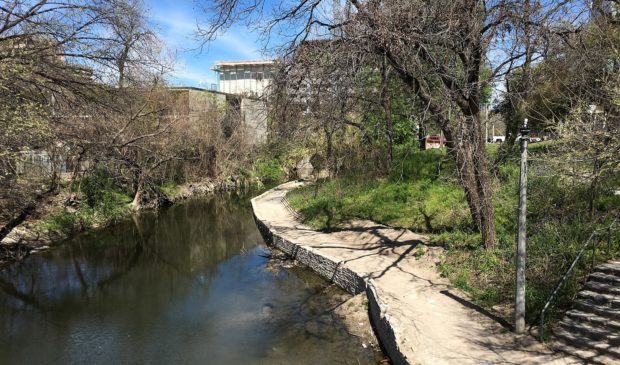Council considering another $110 million for Waller Creek park system
Thursday, March 15, 2018 by
Jack Craver City Council members have expressed interest in the idea of extending the life of a tax increment reinvestment zone that was set up to fund the Waller Creek chain of parks, an ongoing project that city government is betting will become a cultural and recreational gem that will spur further economic activity downtown.
It is unclear, however, whether those plans will be affected by the recent announcement by the city that the Waller Creek Tunnel, the anchor of the project vision, wasn’t built correctly.
At a Council work session on Feb. 27, more than a week before the bad news about the tunnel broke, city staff presented the argument for extending the life of the TIRZ. It is supposed to run through 2027, and staff proposed ending it in 2040.
The city set up the TIRZ in 2007 as part of a long-term plan to restore Waller Creek and its surroundings, which had been badly eroded by flooding and become a largely neglected eyesore. The city issued $106 million of debt to fund the construction of the tunnel and to convert much of the surrounding flood plain into parkland.
The idea behind the TIRZ, as is usually the case with tax increment financing, is that the investment of public money spurs an increase in property value and the resulting rise in property tax revenue pays back the investment.
During the life of the TIRZ, taxes generated from whatever the property value was in the base year of the zone are collected and go into the city’s General Fund, just like any other. Any taxes levied on new growth, however, are dedicated to paying off the debt. If the debt is paid off before the TIRZ ends, the city might opt to continue dedicating the revenue from the district to a specific purpose, such as investing in further improvements in the area.
Given the dramatic increase in the property value downtown over the past decade, including in the Waller Creek zone, the city has had no problem generating the revenue to pay off the $106 million in debt.
City leaders are now considering investing another $110 million in the park system, to be paid off by further increases in downtown property values over the next two decades.
Last year, staff floated the idea of not only extending the life of the TIRZ but expanding it to include other areas of downtown. The geographic expansion, however, appears to be off the table now. Deputy Chief Financial Officer Greg Canally told the Austin Monitor that there simply wasn’t a need.
While the plan calls for a “maximum” commitment from the city of $110 million, it anticipates significant financial assistance from the Waller Creek Conservancy, a private nonprofit that has raised millions of dollars since its founding in 2011 to support the development of the 5-mile chain of parks and trails.
City staff is projecting confidence not only that another major investment will be paid off by continued growth in property values downtown, but that the transformation of Waller Creek into a world-class example of urban green space will generate even further economic development.
“We’ve seen anecdotally that that has occurred throughout the country,” said Interim Assistant City Manager Sara Hensley, citing New York City’s High Line and the East Bay Regional Park District in San Francisco.
At the February meeting, Council members expressed excitement about the future park.
Mayor Steve Adler, Mayor Pro Tem Kathie Tovo and Council Member Ora Houston all expressed delight at the recent public forums organized in February by the Waller Creek Conservancy, one at the Emma S. Barrientos Mexican American Cultural Center and one at the Metz Recreation Center in the Holly neighborhood in East Austin.
“It was the most diverse community event I’ve ever attended in the city of Austin,” said Adler. “Seeing that was just great.”
Houston concurred, applauding group CEO Peter Mullan for “going into communities where the Parks Conservancy has never gone.”
Only Council Member Jimmy Flannigan voiced skepticism of extending the TIRZ. Although he called the parks plan great, he said that he was concerned about restricting revenue from a rapidly growing part of the city to one purpose over the next two decades. He said he would like to further analyze the projected property value increases.
Now, the city is demanding that a contractor it hired to build the tunnel, S.J. Louis Construction, pay back $22 million due to what the city claims is shoddy work. The firm has responded by suing the city, arguing that the city has unfairly changed its mind after signing off on the work three years ago.
Tovo told the Monitor that she views the questions surrounding the tunnel as separate from the question of whether to extend the TIRZ and invest more in the parks system. The extension of the TIRZ, she said, “is to fund above-ground improvements,” not to pour more money into the tunnel, which the city has already spent $160 million to construct.
“If we haven’t gotten what we paid for in the below-ground improvements, we need to hold (the contractor) accountable,” said Tovo.
Photo by Fredlyfish4 (Own work) [CC BY-SA 4.0], via Wikimedia Commons.
The Austin Monitor’s work is made possible by donations from the community. Though our reporting covers donors from time to time, we are careful to keep business and editorial efforts separate while maintaining transparency. A complete list of donors is available here, and our code of ethics is explained here.
You're a community leader
And we’re honored you look to us for serious, in-depth news. You know a strong community needs local and dedicated watchdog reporting. We’re here for you and that won’t change. Now will you take the powerful next step and support our nonprofit news organization?








